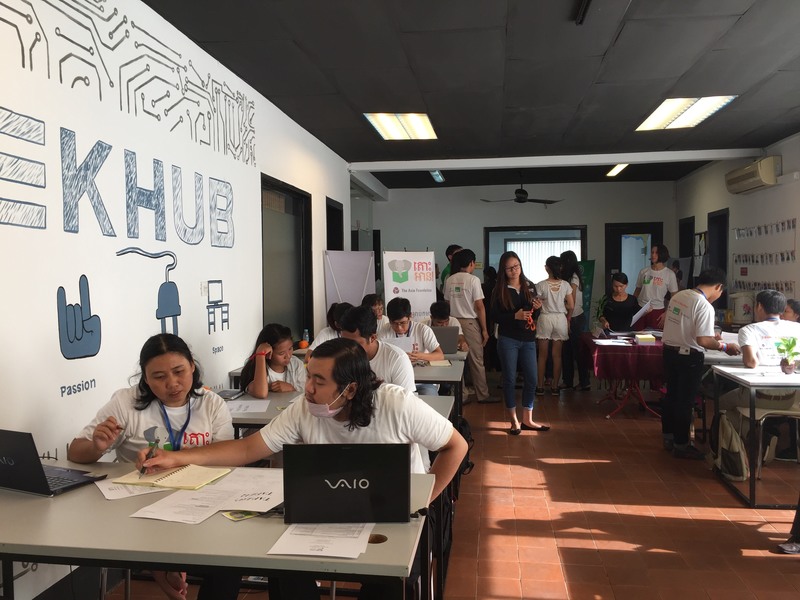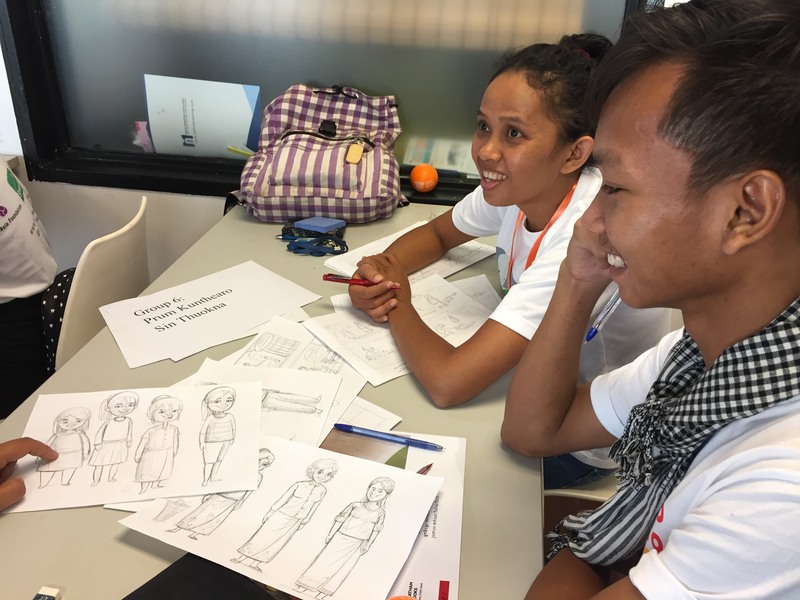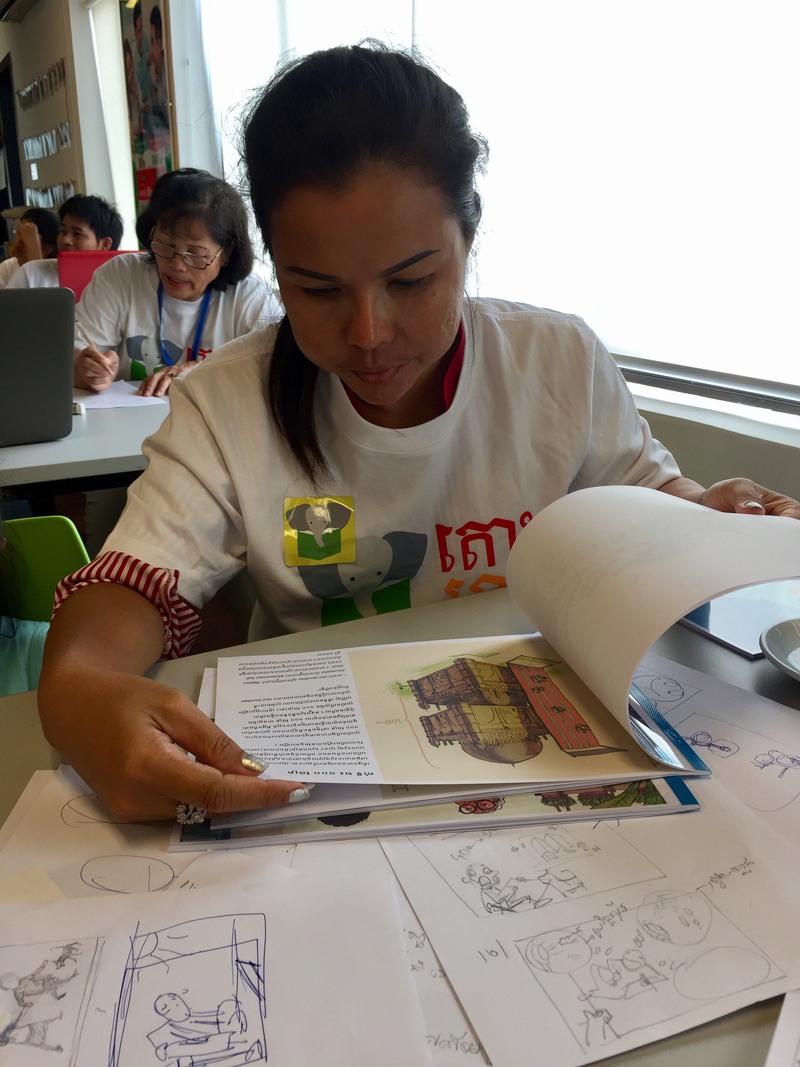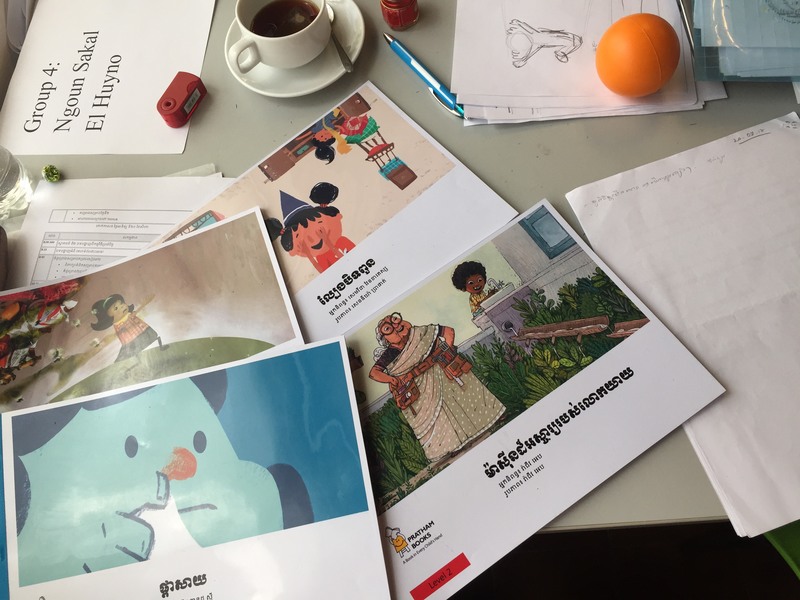StoryWeaver Scores A Century: 100 languages to read, create and translate stories to!
Posted by Remya Padmadas on September 26, 2017Yesterday evening, StoryWeaver achieved a new milestone by adding the one hundredth language to the platform! The team had been keeping an eye on the language counter on the StoryWeaver homepage for the last couple of days as it teetered precariously on 99.
When we launched StoryWeaver two years ago with 800 stories in 24 languages, we really couldn't predict the tremendous reception the platform has had, not just in India but around the world. Today, with over 5000 stories in 100 languages, StoryWeaver is truly a global repository of multilingual stories. And the thing that makes us happiest is that over 40% of the new languages added to the platform have been at the request of YOU, our amazing community!
Once we shared the happy news on Social Media, congratulatory messages started coming in! Here are some of them:
N.Chokkan, Translator and Reviewer
"Thrilled to hear about StoryWeaver hitting the magic 100 (in terms of number of languages). This is a huge milestone in their journey to make every story available to every child in the world. Very happy to be part of this great project in a small way, and looking forward to 100s of more languages and 1000s of new stories, more smiles!"
Vibha Lohani, Writer, Translator and Storyteller
"A HUNDRED LANGUAGES! Wow ... This is remarkable. I came across StoryWeaver a little over a year back and fell in love with the platform as a mother as well as a writer and storyteller. Over the last year, I witnessed the team give a wider reach to the beautiful stories written by eminent authors and community writers by including various languages into the platform. With so many languages dying due to ignorance and neglect, touching the 100 languages milestone is an achievement worthy of applaud. Keep up the good work StoryWeaver!"
Tanvi Bambolkar, Writer and Translator
""It is a huge milestone for a platform that is so inclusive and always ready to accept and adopt the new. StoryWeaver is taking tales from various languages to kids speaking and reading only one language. I am sure it is also helping the kids to learn new languages and new cultures. Like one of my students learnt the Tamil word 'Kottavi' when his mother tongue is Marathi. This will only encourage them to learn new words and get in touch with newer world. Hundred languages, hundred cultures!"
Madhubala Joshi, Writer, Translator and Reviewer
"This is exhilirating, great news! May our clan of languages and readers, translators,illustrators, editors grow! May every child, everywhere have access to books, fun and joy and eventually knowledge."
Sanghamitra Ghosh, Writer, Translator and Reviewer
"No one can ever forget the magic of stories, fables and fairy tales that we hear and read as children. Working for Story Weaver put me back in touch with that wonderfully whimsical world. Nothing makes me happier than knowing that now so many more kids can be a part of this world of wild imagination and possibilities. Happy 100 StoryWeaver."
A BIG thank you from the bottom of our heart to each and everyone of you who has been with us each step of the way, and believes just as passionately as we do in the Pratham Books mission of 'A Book in Every Child's Hand.'
comments (2)Pratham Books at 'Let's Read! E-book Hackathon' in Cambodia
Posted by Yamini Vijayan on September 25, 2017Over the last couple of years, our team at Pratham Books has been focussing on creating simple and engaging picture books that explore STEM (Science, Technology, Engineering and Math) concepts. There is a dearth of interesting information books for early readers in India - especially across Indian languages – and we have actively been trying to bridge that gap. Within two years, we have created around 300 multilingual STEM books (available for free on www.storyweaver.org.in), and also set up STEM libraries around the country.
Having had such a strong focus on STEM, we were delighted to be invited by The Asia Foundation to participate in their e-book hackathon in Phnom Penh, Cambodia, which was aimed at creating openly-licensed STEM books in their local language. Like in India, there are very few children’s books in Cambodia that explore STEM topics imaginatively, and the hackathon was a step towards reducing that gap. Over two days (Aug 19-20, 2017), several local writers, illustrators and designers collaborated to make picture books that were centred around STEM topics. The ‘Let’s Read E-book Hackathon’ was also an attempt at identifying young professionals in the publishing sector, and nurturing their skills.

My role, as an editor from Pratham Books, was to offer editorial guidance over the 2-day event. I got the opportunity to discuss some of the key observations that we had made at Pratham Books while creating STEM-based picture books. In essence: what are the crucial things to bear in mind while creating STEM books for early readers, and what works. Here's what Melody Zavala (Director, Books for Asia) said about the hackathon, "The Asia Foundation uses 'e-book hackathons' to drastically reduce the time and resources needed to produce beautiful, illustrated children’s books on topics missing from the commercial market. We were thrilled to draw on Pratham Books’ experience with STEM titles. In Cambodia, only 3 percent of university students choose to study STEM subjects, according to the Ministry of Education, Youth & Sport. We hope this can be changed by stimulating interest at a young age through fun storybooks."
It was fascinating to watch writers and illustrators work so closely, constanly exchanging ideas and refining the narrative as they progressed. We watched as illustrators brought characters to life, developed storyboards along with their writers, and sketched eye-catching book covers. While the foundations of the book were being laid out, many fundamental questions were tossed around, which eventually helped each story evolve: Is the the title too revealing? Did the perspective of each illustration make sense? Is the illustration merely reflecting the text, or is there scope for additional detail?


Interacting with an enthusiastic group of writers, editors, illustrators and designers gave me plenty of time to reflect on the entire book-creation process, and I returned home feeling rather inspired and rejuvenated. Helping create simple and fun STEM books at Pratham Books has been both challenging and full of discovery, so it was gratifying to be able to share those experiences with others who are also trying to make reading more inclusive. It was also heartening to see some of the Pratham Books titles being distributed at the event and that too, in their local language! The Asia Foundation team had translated several of our titles into Khmer. As a multilingual publisher, nothing gives us more joy!

The 8 local-language books that were created during the 2-day Hackathon will soon be available for free on Let’s Read! - a digital platform that empowers underserved communities in Asia to build digital libraries in their own languages.
You can read more about the STEM hackathon here.
This post was written by Yamini, a Consultant Editor at Pratham Books who represented Pratham Books at the 'Let's Read! E-book Hackathon' in Cambodia.
Be the first to comment.The Zombie Wizard-Cat of Oz (Part 1 of 2)
Posted by Remya Padmadas on September 22, 2017Vinayak Varma, writes and draws things. He has written, guest edited and art directed STEM picture books for Pratham Books. Visit him at www.instagram.com/mixtape.in
Give nine people the exact same brief, and there’s a good chance that you’ll end up with nine different kinds of output. I’ve always been curious to know what happens on that journey between idea and execution, and what makes similar stories live out such different lives in the minds of different artists and writers. This is perhaps the only thing that motivates me to collaborate with others, speaking as a cranky hermit type who prefers working alone.
I write and illustrate for a living (a large part of which has lately been in aid of PB StoryWeaver). Every new project I take on is invariably a triathlon event that begins with a plunge into the Bottomless Pool of Procrastination, followed by a deathly plod across the Minefield of Migraines and a bicycle race through the No-Man’s-Land of Forgotten Deadlines. Somewhere along this crazy path, the odd conceptual tangents that inform the best parts of my work tend to sneak up on me like little ninjas. I'm usually too annoyed or preoccupied while I’m working to make note of precisely how any of it happened, and once the moment has passed and the job is done -- provided that job has any depth, truth or beauty to it -- it's easy enough to shrug and pretend like I'd been hit by some Joycean haiku moment.
But mastery of one’s art comes from understanding the mechanics of these creative accidents. If you can unpack it, you can duplicate it. However, the trouble with writing stories or making art is that they require you to exist in an isolated, meditative bubble where you're engaging deeply with the problem at hand, whereas the route to this bubble is through much distraction and muddled thinking. In order to parse the finer workings of this process, you need to be able to slip outside of your bubble at will (while maintaining an accessible distance), catch yourself in the act of being creative, and then be detached enough to pause and document what's happening. It’s a dilemma akin to that of Schrodinger’s cat -- the creative moment exists in a sort of delicate half-alive, half-dead state, where the very act of observing it risks killing it.
Of course, there are other, loftier parts to publishing, from where one can gain an interesting new vantage of some these abstract areas of book-making: hello and welcome to the Highlands, where clowders of editors scour the hillsides for errant adverbs like goats looking for tasty trash. These are cold, dry places where many authors and illustrators don’t dare venture for fear of losing their precious senses of self. Well, I do go there every so often, because I’m foolhardy like that. Here’s what I discovered up there: nothing returns your inner moggie to its quantum state like stage-managing the creation of picture books (as opposed to being one of the actors out in front). Editing and art directing let you view and gently influence the many moving parts of a project, watching creativity in action, without the blinding pressure of being the primary authorial voice. You get to observe the zombie cat but, also, you ARE the zombie cat. I recommend this exercise to all writers and illustrators at least once in their careers: not only does it let you see how other people make things, thereby enriching your own work, but it also acquaints you with the terrible power and omnipotence that commissioning editors have to live with daily. This can build empathy, if nothing else.
I got my most recent taste of this awesome power last year when I was hired to commission a set of nine STEM picture books for Pratham Books' StoryWeaver. I planned, ideated, edited and art directed four of these, which were on science. I got to art direct another four, from editor Bijal Vachharajani’s set of environment-themed stories. And I wrote and illustrated the ninth, themed on emotional intelligence, which meant that I too got to make, even as I guided and observed others in the act of making. In sum, I got to pull back the curtain and see all the wheels turn at once, to catch the decaying particle as it sped towards the poison vial, to expose the regular dude masquerading as… as…. a wizard… no, a dead cat… no, a living cat… no, a mountain goat... Look, the point is: this scarecrow has a fresh, insight-filled brain now. Chew on that, zombies.
I’m going to try and share some of that insight (or at least a bit more about the merits to following my particular path to such insight) in part 2 of this post, next week. Meanwhile, let’s look at some of the books that I just mentioned:
The Science Books
For the set of science books that I had to both edit and art direct, I was asked to come up with a few interesting themes and story ideas, and, once they'd been approved in-house, to farm them out to freelance writers and illustrators who were best suited to each idea. Four stories were then shortlisted from the seven or eight ideas that I suggested to my commissioning editors at Pratham Books (yes, even commissioning editors like me have commissioning editors, who in turn have other, bigger, older commissioning editors, who answer to still larger, greyer commissioning editors, etcetera, etcetera, all the way down, like the proverbial Jenga-stack of cosmic turtles).
I'm going to show you exactly how rudimentary these four early ideas were, so that you can gasp and grow silent with awe when you see what they ultimately became in the hands of my talented gang of writers and illustrators. Hold onto your seats.
--
"Dear Commissioning Space-Turtle #X,
Here are some ideas:
1. A kid has a cold. S/he then gives it to everyone else in his/her class via sneezes and things. Because epidemiology, boss.
2. An old lady heads out with a walking stick and her grandkid in tow. She uses her stick in various fun ways during the walk, pushing, pulling, propping up, etc., thereby demonstrating how simple machines work. Because physics and stuff, boss.
3. On birds devolving into dinosaurs, a la the chickenosaurus conjecture. Cluck, roar, repeat. Because why the hell not.
4. Crocodiles? Reptiles? Rom Whitaker? Because conservation biology, kids.
+ a few more that probably aren't worth going into given space(!)-constraints in this fake-email-within-an-already-interminable-blog-post.
Sincerely,
Commissioning Space-Turtle #Y"
--
As you can see, the whole scheme began with a pith of one-liners that bore a 50-50 potential to go either way: to turn into something halfway-decent, or utter trash. What emerged at the end of their gritty evolution into book-hood, though, would you believe it, were these beauties:
Sniffles: in which Sunando C used bold, striking illustrations and crisp storytelling to turn a sad and lonely germ of an idea into a full-blown epidemic of football and high-fives and cool hats and general cuteness (plus, in a more literal sense, a sustained spray of sneezes, sickness and snot, so keep your antiseptic soaps handy). And those colours! Those characters! Those compositions! Those Norman-Jewison-esque split-screens! Killer stuff!

Ammachi's Amazing Machines: It’s like that original walking stick idea has been sliced up and Frankensteined by a mad surgical team consisting of Rube Goldberg, Professor Branestawm, Mr. Bean and Sathyan Anthikkad. Here’s what I’m interested in knowing: is there anything Rajiv Eipe can't do? Seriously, is there? I've asked everyone, and no one seems to have the answer. I'm willing to pay good money for this information. (Also: simple-machine barfi, FTW.)

Kaakasaurus: Terrifying, scaly, toothy, large, angry, feathery, strange, destructive, and hungry are all adjectives that one could apply to Shalini Srinivasan and Prabha Mallya (but I’m told it would be impolite to do so). Their picture book, however, is all of those words, but also happy, shiny, funny, smart, and crunchy like a hot bajji. There’s a Jurassic Park spin-off script in there somewhere, by the way, and Spielberg (or Robot Shankar) would be well advised to quickly option it while this crow is still a crow.

Ghum-Ghum Gharial’s Glorious Adventure: Now here is a story you can lose yourself in; a deeply affecting bildungsroman about the meaning of family, about love, loss and self-actualisation. The story and art by Aparna Kapur and Roshan, respectively, are so rich with truth, heart and lyricism. It ticks all the right literary / artistic boxes, I tell you. What makes this book truly stand apart, though, is that it’s also filled with an incredible polyphony of nose-wart-blasted fart-noises. Beat that, Odysseus!

You should go read these books, and share them with your kids, if you haven’t already. Did I mention that they’re all free? No? Well, they are too. The links are in the book titles (above). This is your cue to leave this page. GO!
Next week, in part 2 of this post: Four more picture books, more monstrously mixed metaphors (and other atrocious alliterations), an angry, angry, angry kid, and the Final Fate of Quantum Limbo Cat!
Be the first to comment.